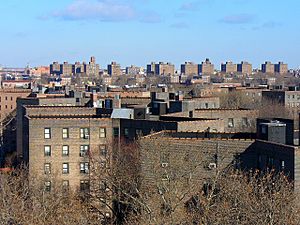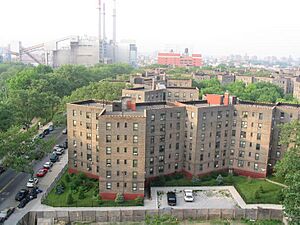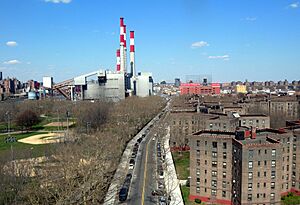Queensbridge, Queens facts for kids
Quick facts for kids
Queensbridge Houses
|
|
|---|---|
|
NYCHA property
|
|
 |
|
| Nickname(s):
Queensbridge, QB
|
|
| Country | |
| State | |
| City | New York City |
| Borough | Queens |
| ZIP codes |
11101
|
| Area code(s) | 718, 347, 929, and 917 |
Queensbridge Houses, often called Queensbridge or QB, is a huge community of apartment buildings in the Long Island City area of Queens, New York City. It is owned by the New York City Housing Authority (NYCHA), which manages public housing. This complex has 3,142 apartments and is the largest of its kind in the Western Hemisphere. About 6,907 people live here in two main sections, North and South. Queensbridge Houses first opened in 1939. It is located in Queens Community District 1, and its ZIP Code is 11101.
Contents
Exploring Queensbridge: A Giant Community
Queensbridge is the biggest of 26 public housing communities in Queens. It sits between Vernon Boulevard, which runs along the East River, and 21st Street. The complex is just south of the Ravenswood power plant. It is also north of the Queensboro Bridge, which is where the community gets its name. Queensbridge is the largest housing project in all of North America.
The community is split into two parts: the North Houses on 40th Avenue and the South Houses on 41st Avenue. The Queensbridge subway station is on 21st Street, right next to the complex.
Unique Building Designs
The buildings at Queensbridge are six stories tall and each has 96 apartments. They have a special "Y" shape, with two Y's connected at the bottom. Architects hoped this design would give people more privacy and sunlight than older, cross-shaped buildings. This design was also cheaper to build. To save even more money, the first elevators only stopped on the 1st, 3rd, and 5th floors.
W.F.R. Ballard, Henry S. Churchill, Frederick G. Frost, and Burnett Turner were the architects who designed Queensbridge. The buildings are a worn grayish-brown color. Each building has a red painted base, about four feet high. This makes the whole complex feel connected. Signs from the New York City Housing Authority show the project's name, "Queensbridge North" or "Queensbridge South."
You need a key or an intercom system to get into the buildings. The hallways inside are simple, with light blue tiles. The apartments are painted white and are quite small. Elevators have been updated and now stop on every floor (1, 2, 3, 4, and 5). Kitchens have also been renovated with new refrigerators. In 2000, 3,000 bathrooms were updated with new tubs, toilets, and lighting.
Fun Places and Activities

When Queensbridge was first planned, it included some basic fun spots. There was a central shopping area, a nursery, and six courtyards for playing. In the 1950s, there were also three playschool rooms and a library. A community center had an auditorium for shows and a gym that was used for roller skating.
Kids could join activities like tap dancing, ballet, art, and music. There were also Girl Scout and Boy Scout meetings. During hot summer months, residents enjoyed concerts in the main shopping area.
The buildings are separated by paths and small grassy areas. There are also basketball courts and play areas with benches. Across Vernon Boulevard is Queensbridge Park. This park has a lit baseball field, running paths, and places for picnics. It's a main spot for fun for people living in Queensbridge. The park also hosts many summer concerts with different types of music. From the 1950s to 1970, Queensbridge Park was called "River Park." There was also a smaller park called "Baby Park" right under the Queensboro Bridge, but it closed. A new playground for young children replaced it within Queensbridge Park.
Who Lives in Queensbridge?
As of 2013, Queensbridge was home to 6,105 people. Most residents, about 61.4%, were black. About 30.1% were Hispanic or Latino. Other groups included 2.3% white, 1.9% Asian, 1.0% American Indian, and 2.4% multiracial people.



